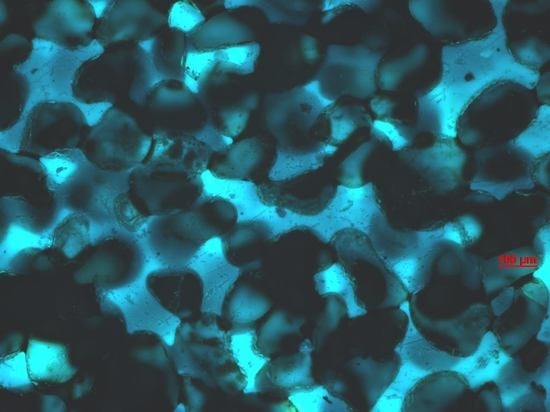Increasing Density of 3D-Printed Sandstone through Compaction
Abstract
:1. Introduction
2. Materials and Methods
2.1. 3D Printing of Specimens
2.2. Sand Mixtures
2.3. 3D Printing Process
2.4. Unconfined Compressive Strength Testing
2.5. Porosity Measurements
3. Results and Discussion
3.1. Unconfined Compressive Strength
3.2. Porosity and Density
3.3. Morphology and Microstructure
4. Conclusions
Author Contributions
Funding
Conflicts of Interest
References
- Yang, Y.; Liu, Z.; Sun, Z.; An, S.; Zhang, W.; Liu, P.; Yao, J.; Ma, J. Research on stress sensitivity of fractured carbonate reservoirs based on CT technology. Energies 2017, 10, 1833. [Google Scholar] [CrossRef] [Green Version]
- Bell, F.; Lindsay, P. The petrographic and geomechanical properties of some sandstones from the Newspaper Member of the Natal Group near Durban, South Africa. Eng. Geol. 1999, 53, 57–81. [Google Scholar] [CrossRef]
- ASTM Standard 52900; Standard Terminology for Additive Manufacturing—General Principles—Terminology. ISO: West Conshohocken, PA, USA, 2015.
- Song, R.; Wang, Y.; Ishutov, S.; Zambrano-Narvaez, G.; Hodder, K.; Chalaturnyk RSun, S.; Liu, J.; Gamage, R. A Comprehensive Experimental Study on Mechanical Behavior, Microstructure and Transport Properties of 3D-printed Rock Analogs. Rock Mech. Rock Eng. 2020, 53, 5745–5765. [Google Scholar] [CrossRef]
- Squelch, A. 3D printing rocks for geo-educational, technical, and hobbyist pursuits. Geosphere 2017, 14, 360–366. [Google Scholar] [CrossRef] [Green Version]
- Gao, Y.; Wu, T.; Zhou, Y. Application and prospective of 3D printing in rock mechanics: A review. Int. J. Miner. Metall. Mater. 2021, 28, 1–17. [Google Scholar] [CrossRef]
- Kong, L.; Ostadhassan, M.; Li, C.; Tamimi, N. Pore characterization of 3D-printed gypsum rocks: A comprehensive approach. J. Mater. Sci. 2018, 53, 5063–5078. [Google Scholar] [CrossRef]
- Jiang, C.; Zhao, G.; Zhu, J.; Zhao, Y.; Shen, L. Investigation of dynamic crack coalescence using a gypsum-like 3D printing material. Rock Mech. Rock Eng. 2016, 49, 3983–3998. [Google Scholar] [CrossRef]
- Hodder, K.; Nychka, J.; Chalaturnyk, R. Process limitations of 3D printing model rock. Prog. Addit. Manuf. 2018, 3, 173–182. [Google Scholar] [CrossRef]
- Hodder, K.; Nychka, J.; Chalaturnyk, R. Improvement of the unconfined compressive strength of 3D-printed model rock via silica sand functionalization using silane coupling agents. Int. J. Adhes. Adhes. 2018, 85, 274–280. [Google Scholar] [CrossRef]
- Ardila, N.; Zambrano-Narvaez, G.; Chalaturnyk, R. Wettability Measurements on 3D Printed Sandstone Analogues and Its Implications for Fluid Transport Phenomena. Transp. Porous Media 2019, 129, 521–539. [Google Scholar] [CrossRef]
- Deisman, N.; Flottmann, T.; Guo, Y.; Hodder, K.; Chalaturnyk, R.; Leonardi, C. Using 3D Printed Synthetic Rock for Systematic Evaluation of Mechanical Properties in Coal. In Proceedings of the Asian Pacific Unconventional Resources Technology Conference, Brisbane, QLD, Australia, 18–19 November 2019; p. 198255. [Google Scholar]
- Gomez, J.; Chalaturnyk, R.; Zambrano-Narvaez, G. Experimental Investigation of the Mechanical Behavior and Permeability of 3D Printed Sandstone Analogues Under Triaxial Conditions. Transp. Porous Media 2019, 129, 541–557. [Google Scholar] [CrossRef] [Green Version]
- Hodder, K.; Nychka, J. Silane Treatment of 3D-Printed Sandstone Models for Improved Spontaneous Imbibition of Water. Transp. Porous Media 2018, 129, 583–598. [Google Scholar] [CrossRef]
- Osinga, S.; Zambrano-Narvaez, G.; Chalaturnyk, R. Study of geomechanical properties of 3D printed sandstone analogue. In Proceedings of the American Rock Mechanics Association, San Francisco, CA, USA, 28 June–1 July 2015; ARMA: Overland Park, KS, USA, 2015; pp. 15–547. [Google Scholar]
- Primkulov, B.; Chalaturnyk, J.; Chalaturnyk, R.; Zambrano-Narvaez, G. 3D Printed Sandstone Strength: Curing of Furfuryl Alcohol Resin-Based Sandstone. 3D Print. Addit. Manuf. 2017, 4, 149–155. [Google Scholar] [CrossRef]
- Perras, M.; Vogler, D. Compressive and Tensile Behavior of 3D-Printed and Natural Sandstones. Transp. Porous Media 2018, 129, 559–582. [Google Scholar] [CrossRef]
- Gregorski, S. High Green Density Metal Parts by Vibrational Compaction of Dry Powder in the Three Dimensional Printing Process. Ph.D. Thesis, Massachusetts Institute of Technology MIT, Cambridge, MA, USA, 1996. [Google Scholar]
- Ayer, J.; Soppet, F. Vibratory Compaction: II, Compaction of Angular Shapes. J. Am. Ceram. Soc. 1996, 49, 207–210. [Google Scholar] [CrossRef]
- Bai, Y.; Wagner, G.; Williams, C. Effect of Particle Size Distribution on Powder Packing. J. Manuf. Sci. Eng. 2017, 139, 081019. [Google Scholar] [CrossRef] [Green Version]
- Mostafaei, A.; Rodriguez De Vecchis, P.; Nettleship, P.; Chmielus, M. Effect of Powder Size Distribution on Densification and Microstructural Evolution of Binder-Jet 3D Printed Alloy 625. Mater. Des. 2019, 162, 375–383. [Google Scholar] [CrossRef]
- Ziaee, M.; Crane, N. Binder jetting: A review of process, materials, and methods. Additive Manuf. 2019, 28, 781–891. [Google Scholar] [CrossRef]
- ASTM Standard D7012-14; Standard Test Methods for Compressive Strength and Elastic Moduli of Intact Rock Core Specimens under Varying States of Stress and Temperatures. ISO: West Conshohocken, PA, USA, 2014.
- Zoback, M. Reservoir Geomechanics; Cambridge University Press: Cambridge, UK, 2007. [Google Scholar]
- Das, B. Fundamentals of Geotechnical Engineering, 4th ed.; Brooks/Cole: Pacific Grove, CA, USA, 1999. [Google Scholar]
- Andreola, F.; Leonelli, C.; Romagnoli, M.; Miselli, P. Techniques used to determine porosity. Am. Ceram. Soc. Bull. 2000, 79, 49–52. [Google Scholar]
- Gomez, J.; Ardilla, N.; Chalaturnyk, R.; Zambrano-Narvaez, G. Reservoir Geomechanical Properties Characterization of 3D Printed Sandstone. In Proceedings of the VI Biot’s Conference in Poromechanics, Paris, France, 9–13 July 2017; ASCE: Reston, VA, USA, 2017; pp. 952–960. [Google Scholar]
- Bertei, A.; Nicolella, C. A comparative study and an extended theory of percolation for random packings of rigid spheres. Powder Technol. 2011, 213, 100–108. [Google Scholar] [CrossRef]
- Nelson, P. Permeability-porosity Relationships in Sedimentary Rocks. Log Anal. 1994, 35, 38–62. [Google Scholar]
- Friedman, G. On Sorting, Sorting Coefficients, and the Lognormality of the Grain-Size Distribution of Sandstones. J. Geol. 1962, 70, 737–753. [Google Scholar] [CrossRef]
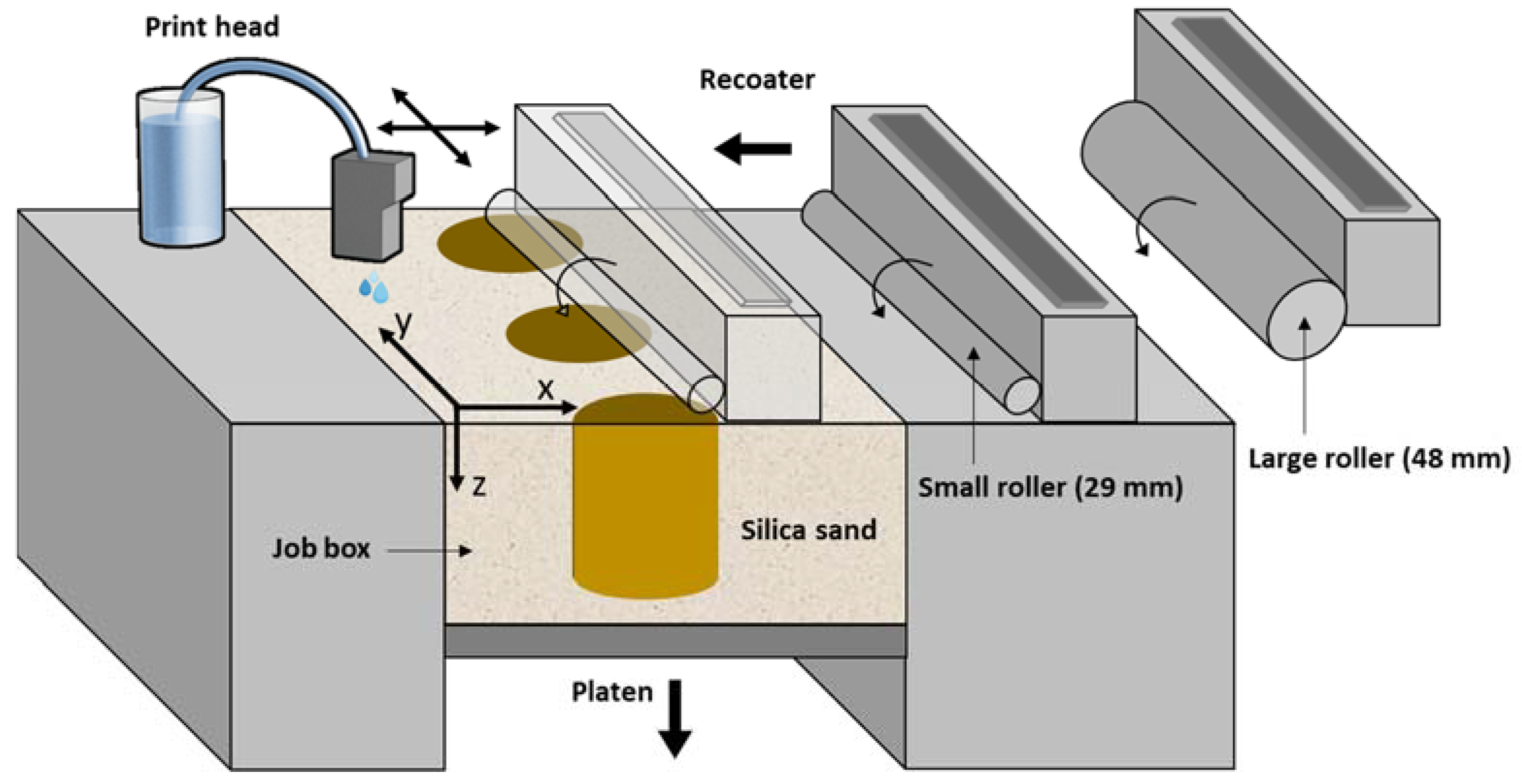
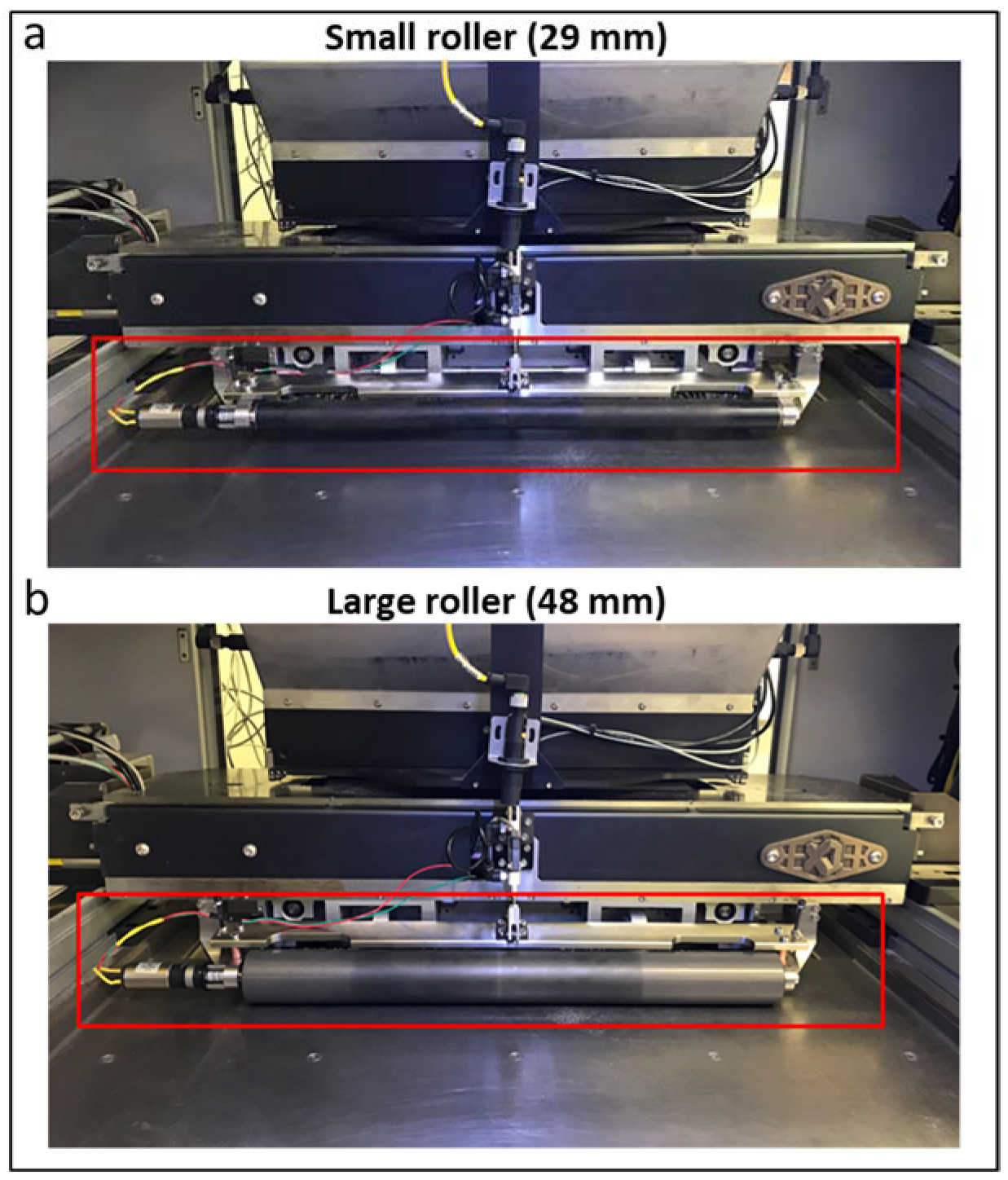
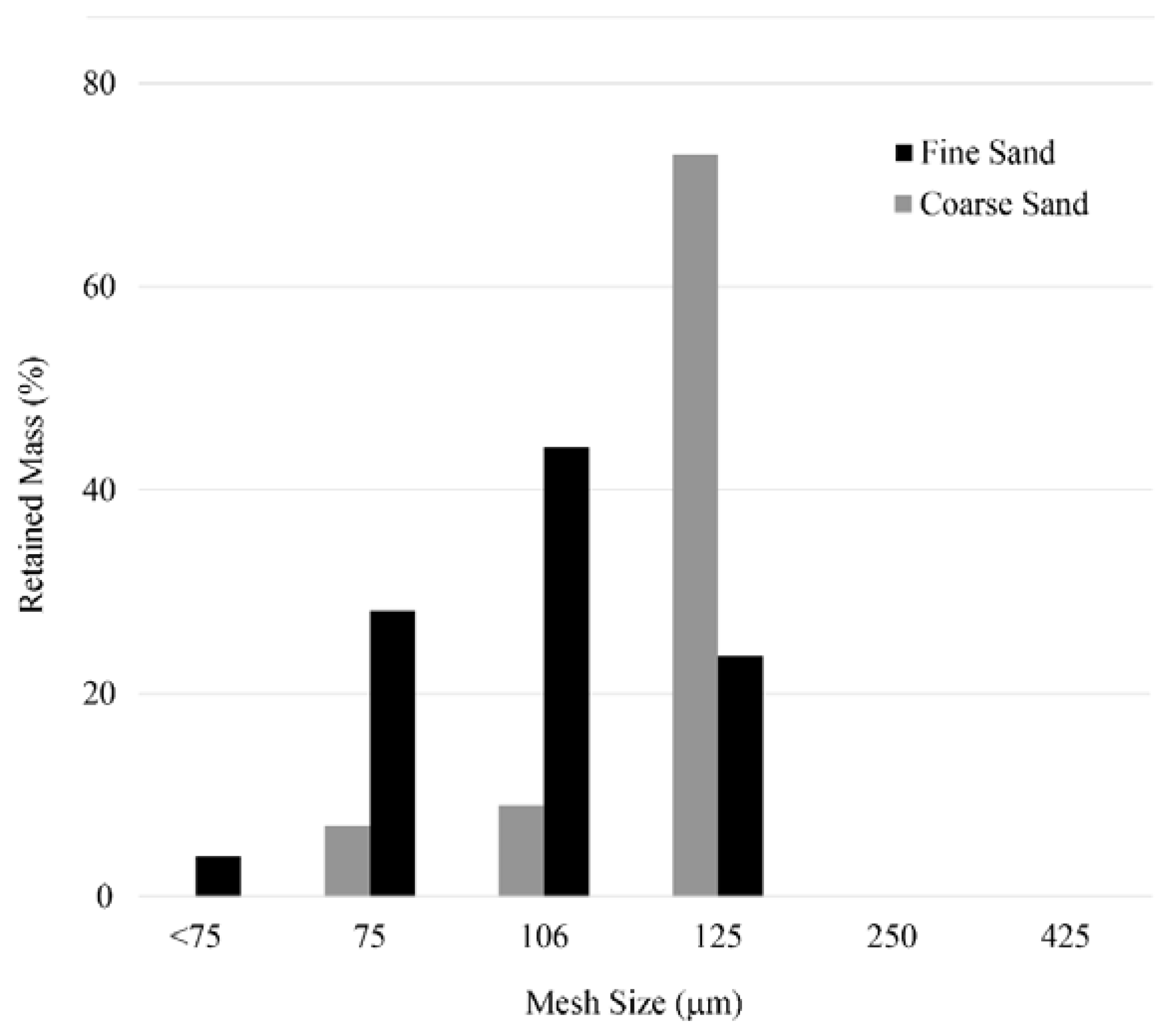
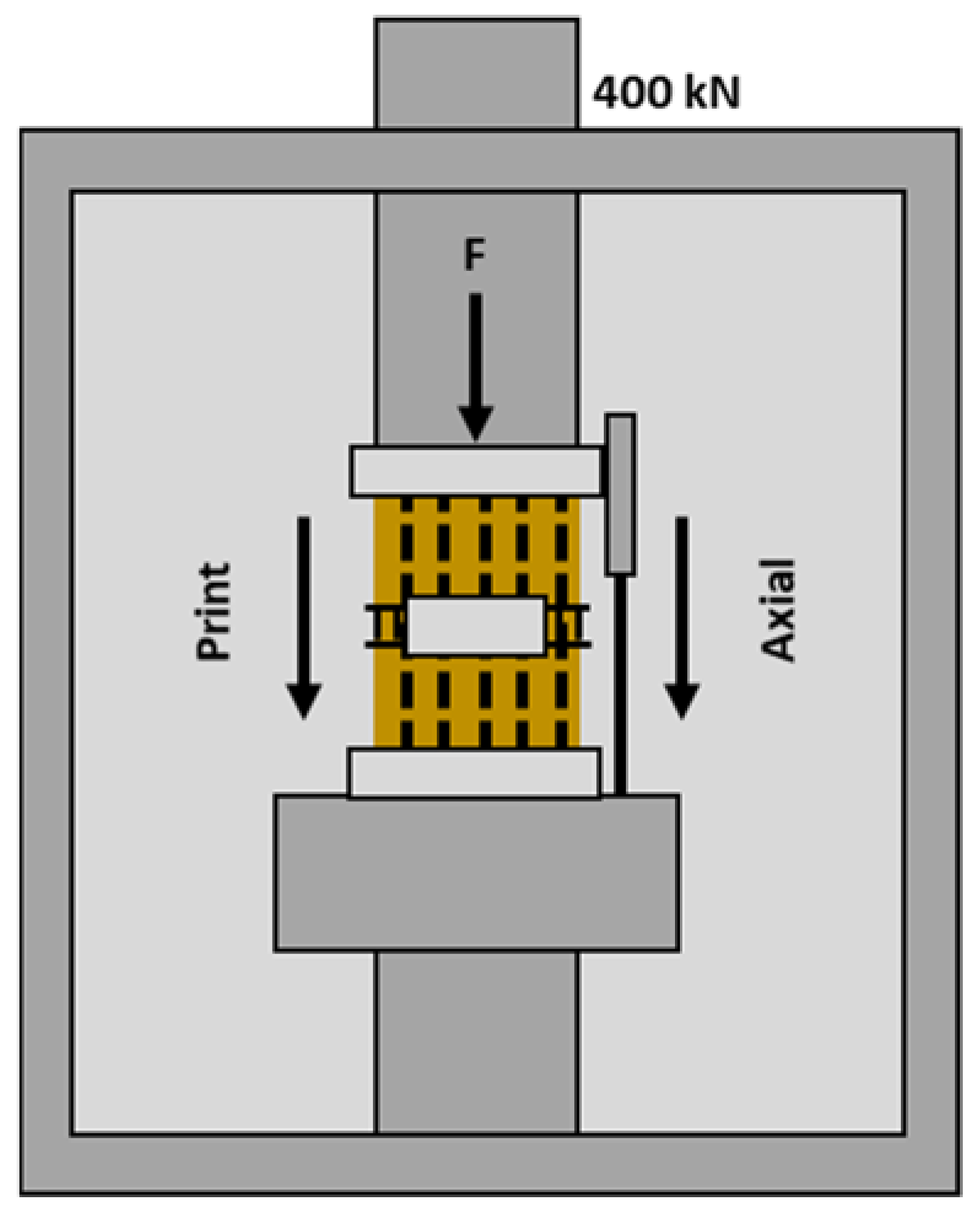
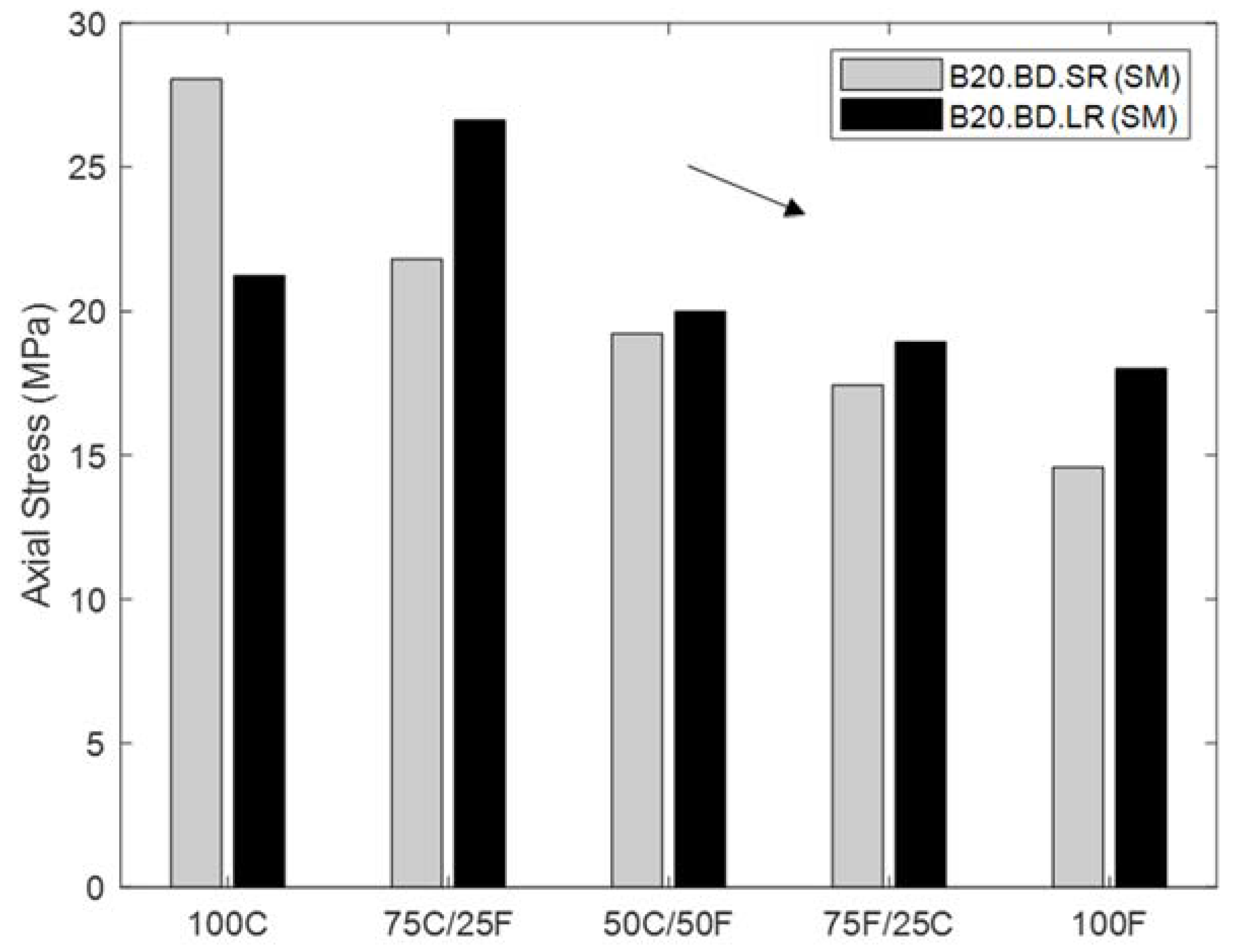
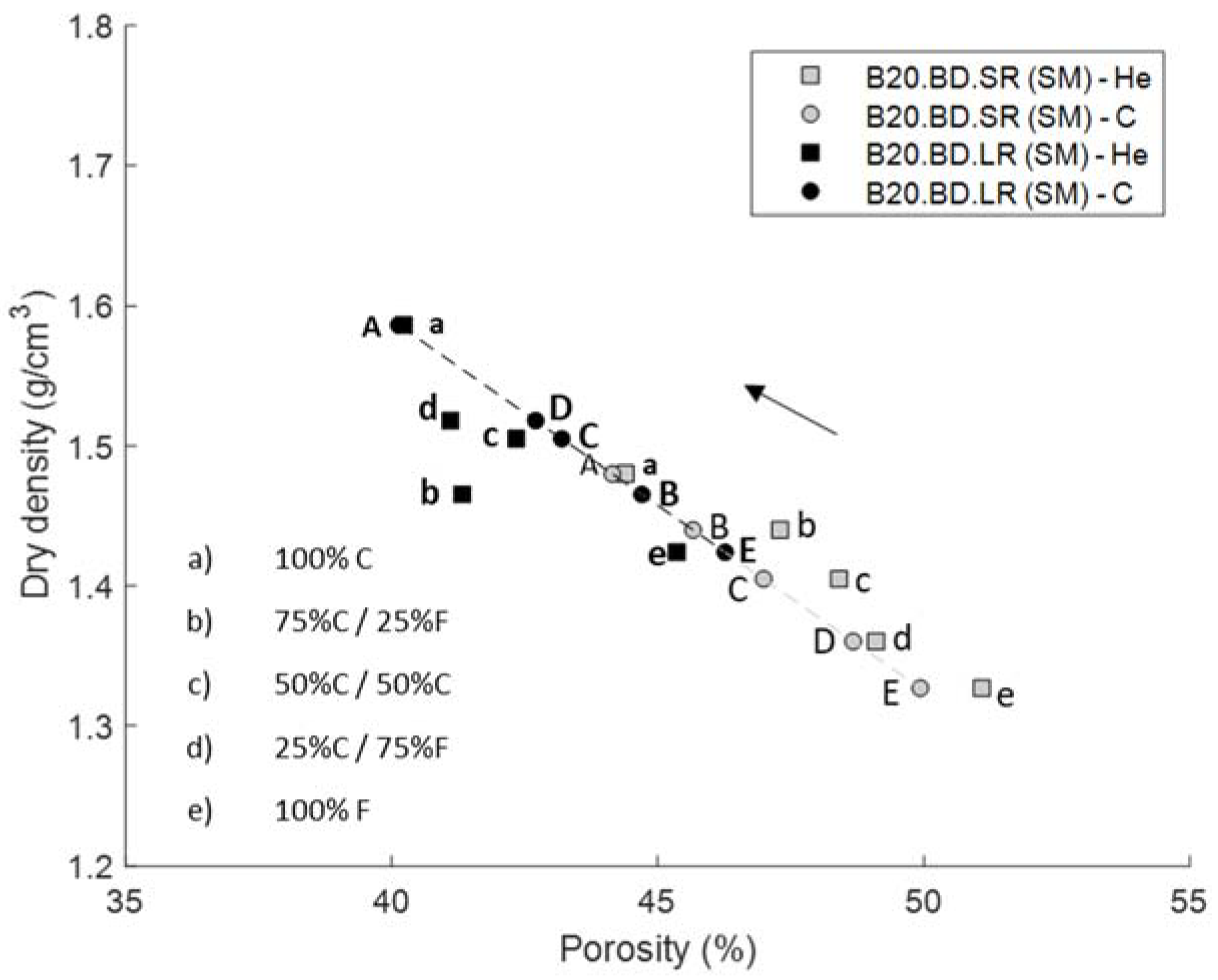


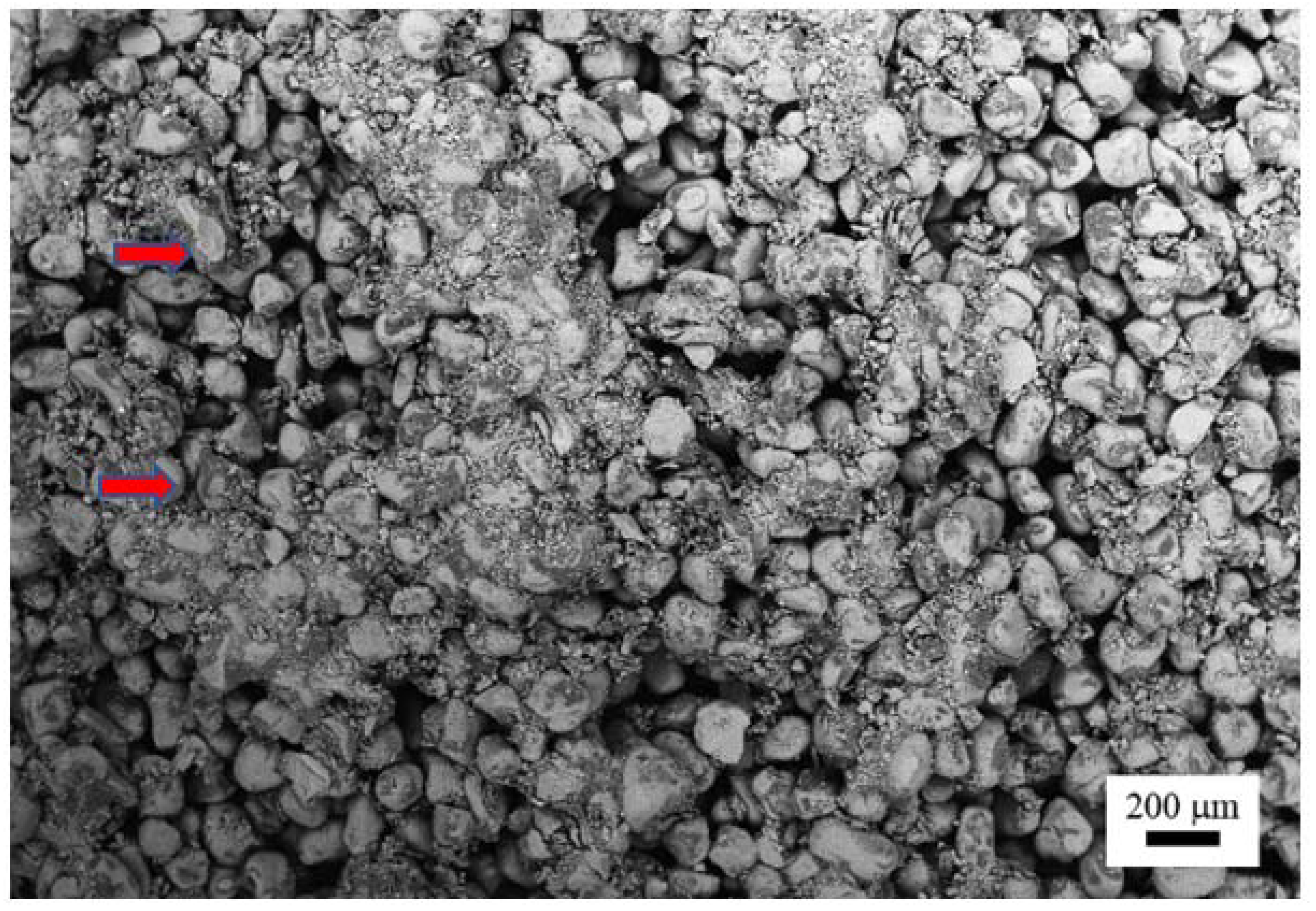
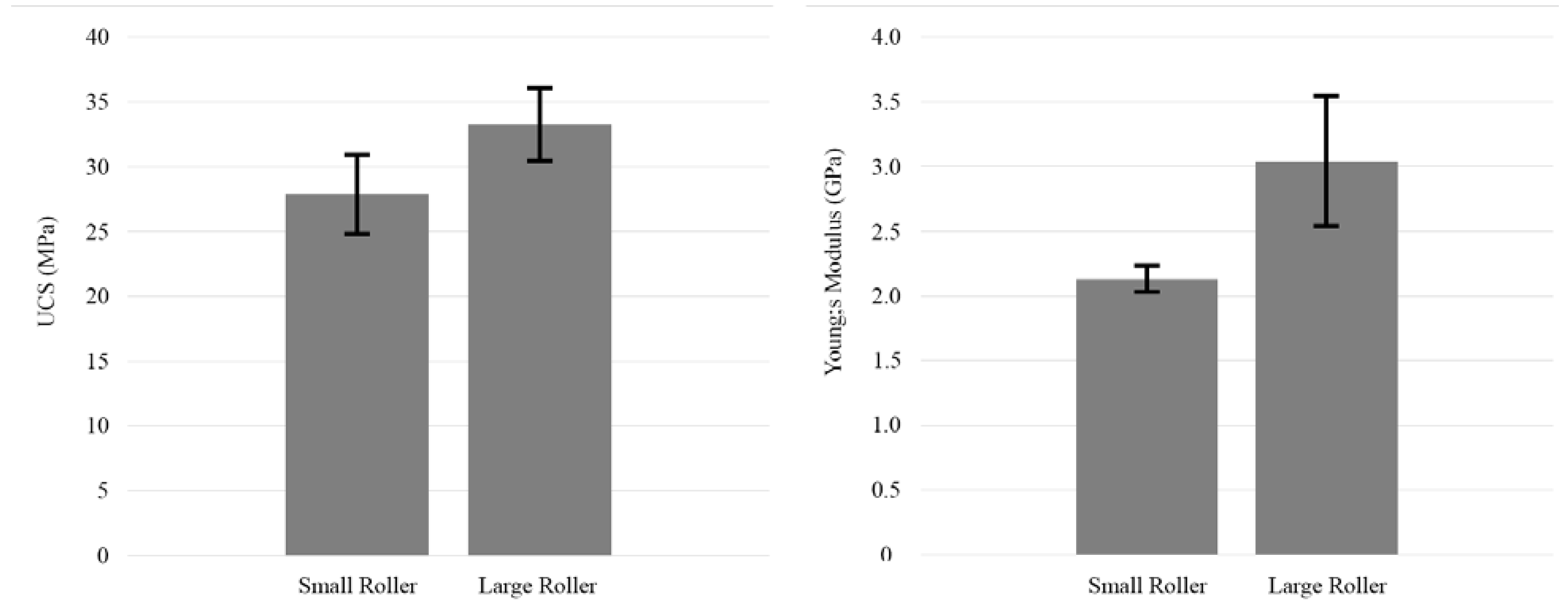
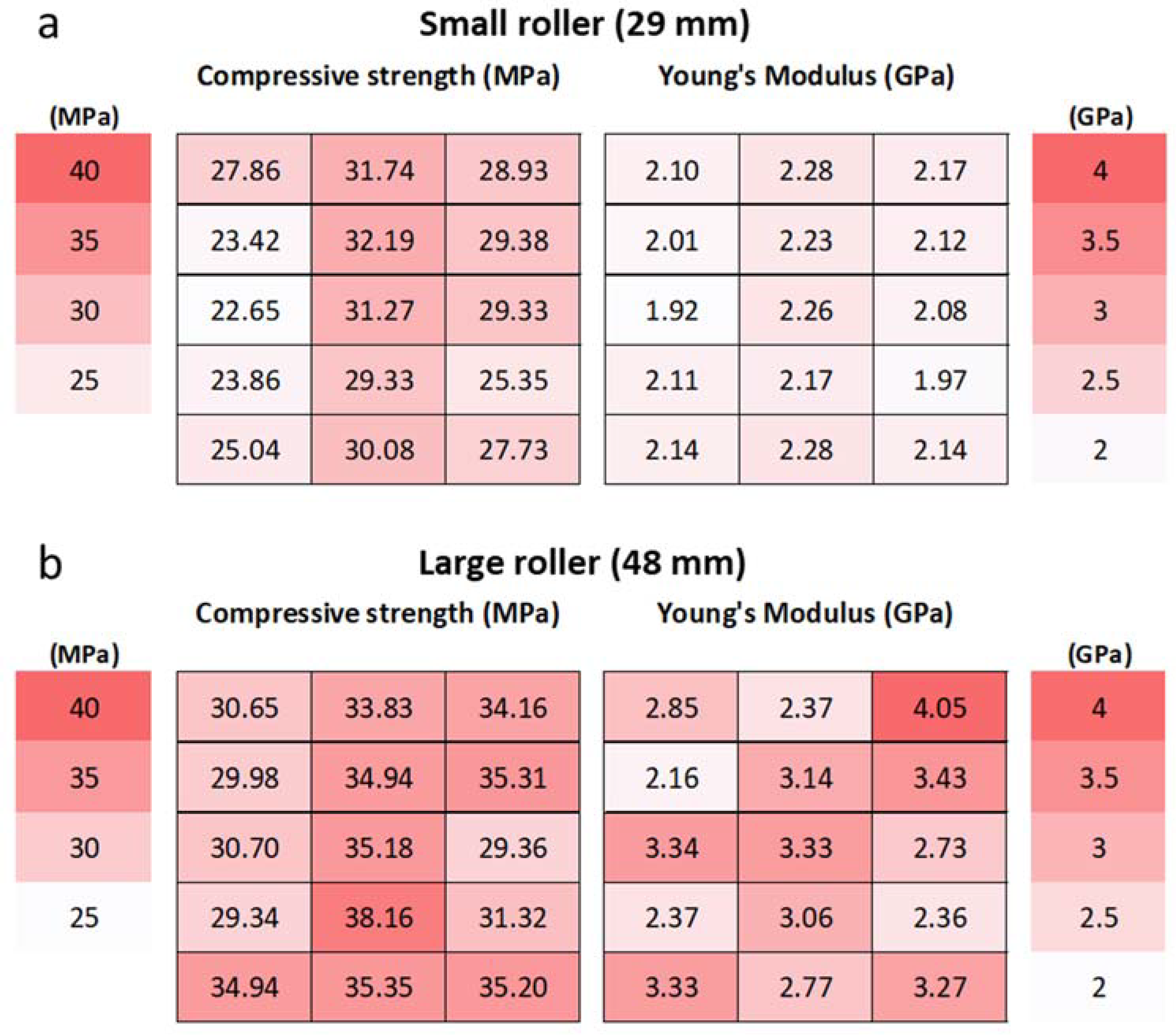
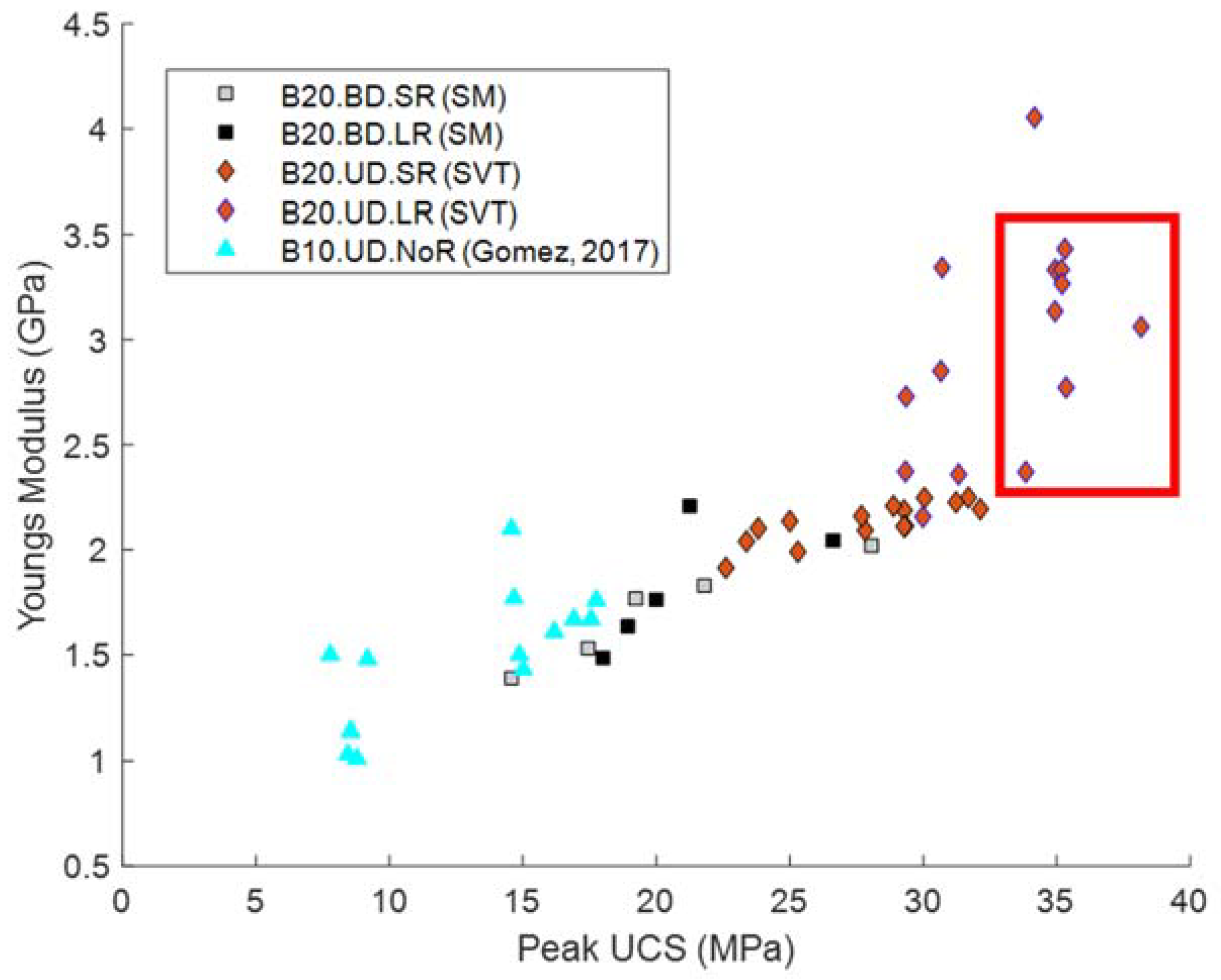
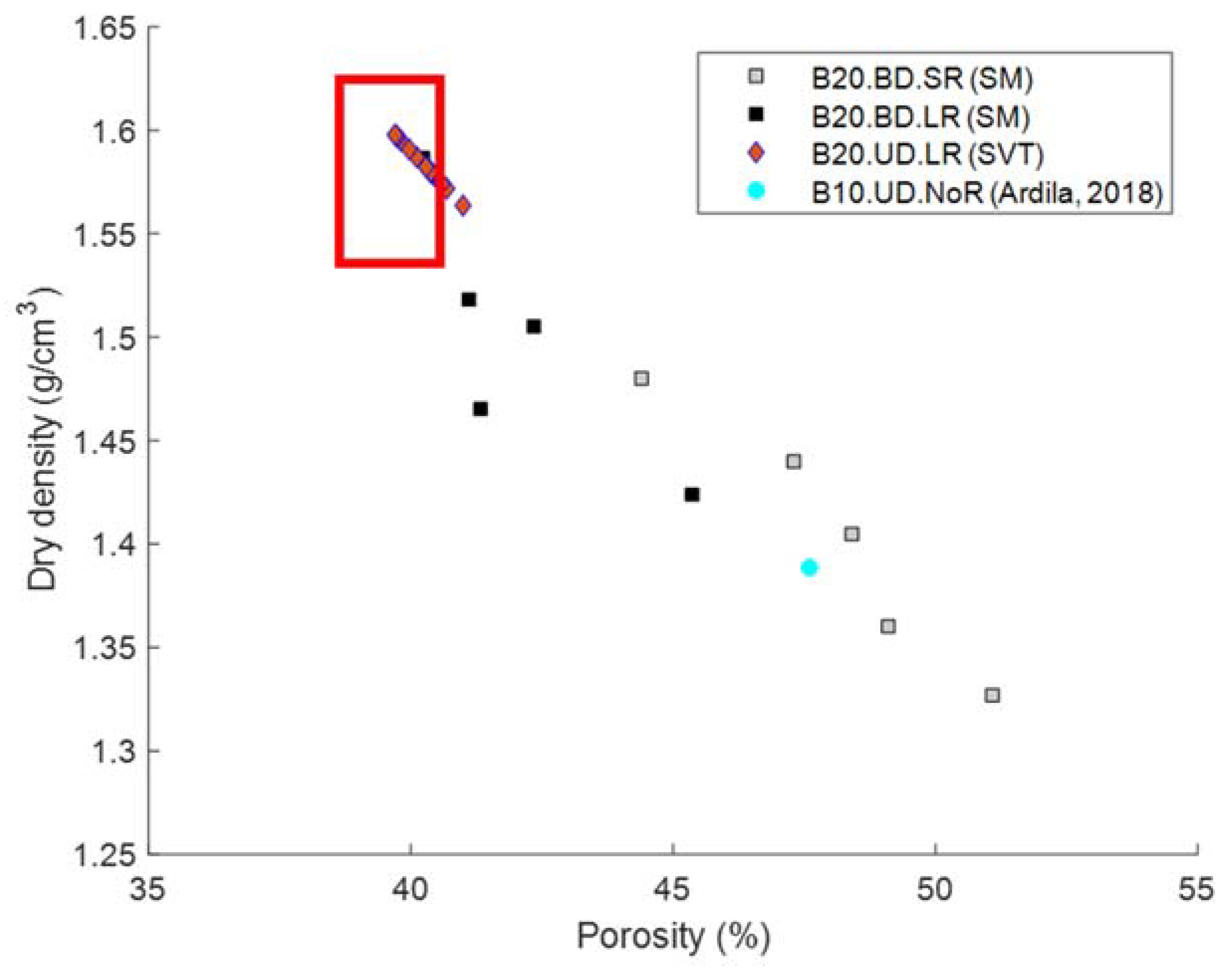
| Sand Mixture | Coarse Sand (wt.) (D50 = 175 μm) | Fine Sand (wt.) (D50 = 105 μm) |
|---|---|---|
| 100C | 100% | 0% |
| 75C/25F | 75% | 25% |
| 50C/50F | 50% | 50% |
| 25C/75F | 25% | 75% |
| 100F | 0% | 100% |
| Sample | Diameter (mm/inch) | Height (mm/inch) |
|---|---|---|
| 1 | 63/2.5 | 127/5 |
| 2 | 38.1/1.5 | 76.2/3 |
| 3 | 12.7/0.5 | 25.4/1 |
| Small Roller (29 mm) | |||
|---|---|---|---|
| Sand Mixture | Porosity (%)—He | Porosity (%)—C (Equation (3)) | Dry Density (g/cm3) |
| 100%C | 44.40 | 44.15 | 1.48 |
| 75%C/25%F | 47.30 | 45.67 | 1.44 |
| 50%C/50%F | 48.41 | 46.99 | 1.40 |
| 25%C/75%F | 49.10 | 48.67 | 1.36 |
| 100%F | 51.09 | 49.93 | 1.33 |
| Large roller (48 mm) | |||
| 100%C | 40.23 | 40.13 | 1.59 |
| 75%C/25%F | 41.33 | 44.71 | 1.47 |
| 50%C/50%F | 42.34 | 43.20 | 1.51 |
| 25%C/75%F | 41.11 | 42.71 | 1.52 |
| 100%F | 45.36 | 46.27 | 1.42 |
Publisher’s Note: MDPI stays neutral with regard to jurisdictional claims in published maps and institutional affiliations. |
© 2022 by the authors. Licensee MDPI, Basel, Switzerland. This article is an open access article distributed under the terms and conditions of the Creative Commons Attribution (CC BY) license (https://creativecommons.org/licenses/by/4.0/).
Share and Cite
Hodder, K.J.; Sanchez-Barra, A.J.; Ishutov, S.; Zambrano-Narvaez, G.; Chalaturnyk, R.J. Increasing Density of 3D-Printed Sandstone through Compaction. Energies 2022, 15, 1813. https://doi.org/10.3390/en15051813
Hodder KJ, Sanchez-Barra AJ, Ishutov S, Zambrano-Narvaez G, Chalaturnyk RJ. Increasing Density of 3D-Printed Sandstone through Compaction. Energies. 2022; 15(5):1813. https://doi.org/10.3390/en15051813
Chicago/Turabian StyleHodder, Kevin J., Angel J. Sanchez-Barra, Sergey Ishutov, Gonzalo Zambrano-Narvaez, and Rick J. Chalaturnyk. 2022. "Increasing Density of 3D-Printed Sandstone through Compaction" Energies 15, no. 5: 1813. https://doi.org/10.3390/en15051813






